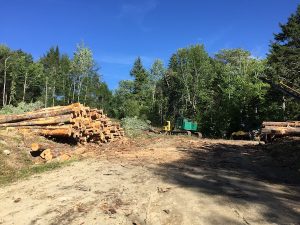Protecting Waters in Forest Operations
2018 Maine Sustainability and Water Conference:
Session Overview: Protecting Waters in Forest Operations
One of the major impacts from any forest operation is related to sedimentation of water bodies. Even though the risk of sedimentation is comparatively less than other land uses, forest operations can have detrimental effects if not properly executed. Over the years, loggers and foresters have adopted several strategies, also known as Best Management Practices (BMPs), to minimize these impacts during the operations.

The talk “An Economic Approach to Estimating the Effectiveness of Forestry BMPs” will focus on various aspects of forest operations related to water bodies, including training programs, stream protection in Maine, and legal aspects. The talk will be led by Master’s student Ariel Listo of the UMaine School of Economics. Assistant professor Adam Daigneault of the UMaine School of Forest Resources and a Mitchell Center Faculty fellow, and consultant Lloyd Irland of The Irland Group are co-authors on the presentation.

In Maine, BMPs in the forest sector are primarily intended to reduce sediment runoff into state waterways. The BMPs are voluntary with the incentive being that implementing them will limit the need for additional water quality protection regulations. As a result, the Maine Forest Service has developed a guidebook, “Best Management Practices for Forestry: Protecting Maine’s Water Quality,” which is a set of lists and checklists of what people can do to protect water bodies during forest operations.
The guidebook is what most foresters and loggers work by but, notes Daigneault, “While it provides a lot of lists of what to do and a bit of the why you should do it, if you’re a land manager or logger and don’t know a lot about the topic, you’re not going to know how much it’s going to cost, what level of effort might be imposed, or ways to tease out whether it’s actually worth your time to invest in one strategy over another.”
Through a literature review and other methods, the researchers have organized the disparate information in an effort to populate and better quantify the BMP strategies and provide more guidance on, for example, what costs might be and when it might be efficient to put in a culvert.

The rule of thumb, Daigneault adds, is the costlier the strategy, the more effective it likely is. But that said, if a small logging operation involves crossing one stream infrequently “it’s probably not worth building a bridge with a culvert—it might be just as efficient to use a simple, temporary bridge or put some brush in the stream to help buffer sedimentation.”
The BMP data are inconsistent on, for example, how much a particular strategy would cost to divert a particular amount of sediment. There is anecdotal information and many studies done in more southern U.S. regions and states and, says Daigneault, “We’ve tried to compile much of that and put it into a Maine context while at the same time realizing that forestry is somewhat different here but much of the costs are the same.”
Ideally, the current research could lead to the development of a toolkit or database that details how people are actually implementing these BMPs, which would help others make better decisions. This is particularly important, according to Daigneault, for the next generation of loggers who will be younger and more technology driven.
The session will provide the new knowledge gathered by the researchers and also facilitate a discussion on how these BMPs get elevated in the next stage.
—David Sims
